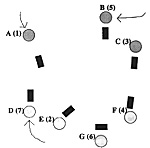
Dominoes can be used for resolving combat in a skirmish (or other type) game. Modifiers to the pips showing on the dominoes can vary the capabilities of units. Double-nine or even double-12 dominoes can be used, but the spread of results may be too great to be generally useful. Those sets also start costing a lot and there are probably more dominoes than needed. Double-six sets can be had for a buck or two. This paper will address the use of double-six dominoes.
Concept: This system is intended to provide for simultaneous results without recordkeeping. It also allows the commander (player) to have the figures attempt certain actions, but their shooting and defensive posture still be open to great variation. They may not even get to move if they come under fire. Modifiers (+3 or -3 would probably be the absolute maximums) would indicate better or worse conditions (cover, etc.) or units, and the dominoes provide randomness.
Procedure: Each player draws a domino; the highest total pips has the first move and selects the figure (his own) that moves first. The first figure moves, and then draws a domino and "aims" it at the enemy target figure. If there is no target or no fire, no domino is drawn. If the enemy figure has not already moved/fired that turn, it must go next. Since it is being fired on before it had a chance to move, it may not move, but may fre (The idea behind this is: sometimes, a figure may not be able to move; other times, he may be able to run right in front of an enemy, since there is no opportunity fire; these events will even out in the course of a game).
Draw and place a domino as before. This process of a targeted figure being the next to move continues until no figure is "activated". In that case, play passes to the next player to the left who has an unmoved figure. Continue until all figures have moved. Many figures, who may be out of sight or out of range of enemy figures, may not even need a domino. If they receive fire, even though they themselves are not firing, draw a domino and place it sideways in front of the figure.
Resolution: After all dominoes are placed, turn them all over. The number closest to the firing figure is the defense number, the number further away is the attack number. If a figure didn't fire and has the domino placed sideways, the greatest number is used for defense. Then simply compare the attack and defense numbers for all situations. If a figure's defense is greater than all attack numbers against him, he survives. If it is lower than any of the attacks, the figure is killed. If it ties an attack, and no attacks are greater, the figure is pinned. Turn it on its side. On the next turn, it is stood up, and may only play a defense domino.
Other ideas: This system could be used for melee combat as well. Certain results could be interpreted as wounds, but markers or paperwork might be needed. Certain figures/vehicles might require two or even more hits in the same turn to take damage. Certain figures/vehicles might get to play two or even more dominoes to show multiple weapons and/or higher defense or attack values. Vehicles may use a pip multiplier instead of just an adder.
Another possibility is to preview the domino, or dominoes, drawn. This would allow a player to choose a high domino for first move (he may or may not want it), or to play them so as to try to preserve a good unit or put powerful fire on a specific enemy unit. This, though, has the effect of allowing a player to "choose" his "dice roll" from a number of choices.
Movement and fire example: Each player draws a domino, and gray wins the first move. 1. A moves and shoots at E. The domino is placed a little forward, so it's obvious which enemy unit, D or E, is being fired on. It is now E's turn. 2. E can't move, since he was fired on, but fires at C. 3. C can't move, but fires on F. 4. F can't move, but returns fire on C. 5. Since a white unit moved last and did not activate a new unit, it is gray's move. B moves and fires on G. 6. G was pinned last turn, and wouldn't have been able to move even if it wasn't fred on. G "stands up" and plays a domino for defense only. 7. It would now be gray's move again, but there are no more gray units. D has not yet been fired on, so D can move and then fire on A. A got to move before being fired on.
All dominoes would next be flipped over and results determined.
Resolution example:
 1. Consider B and G. B either kills or re-pins G, or G is okay. Remove those two dominoes.
1. Consider B and G. B either kills or re-pins G, or G is okay. Remove those two dominoes.
2. The other five units are interrelated by fire (D-A-E-C-F). Consider D against A. A is killed, pinned, or okay. If killed, remove figure (not domino). If pinned, turn figure on side. Remove D's domino.
3. Consider A against E. Resolve and remove A's domino.
4. Consider E and F against C, and C against F. C must beat both attacks to survive unhurt, or must at least tie both to survive pinned. Remove E's domino. Resolve C's fire on F and remove the last two dominoes. Prepare for the next turn.
Back to MWAN #81 Table of Contents
© Copyright 1996 Hal Thinglum
This article appears in MagWeb (Magazine Web) on the Internet World Wide Web.
Other military history articles and gaming articles are available at http://www.magweb.com